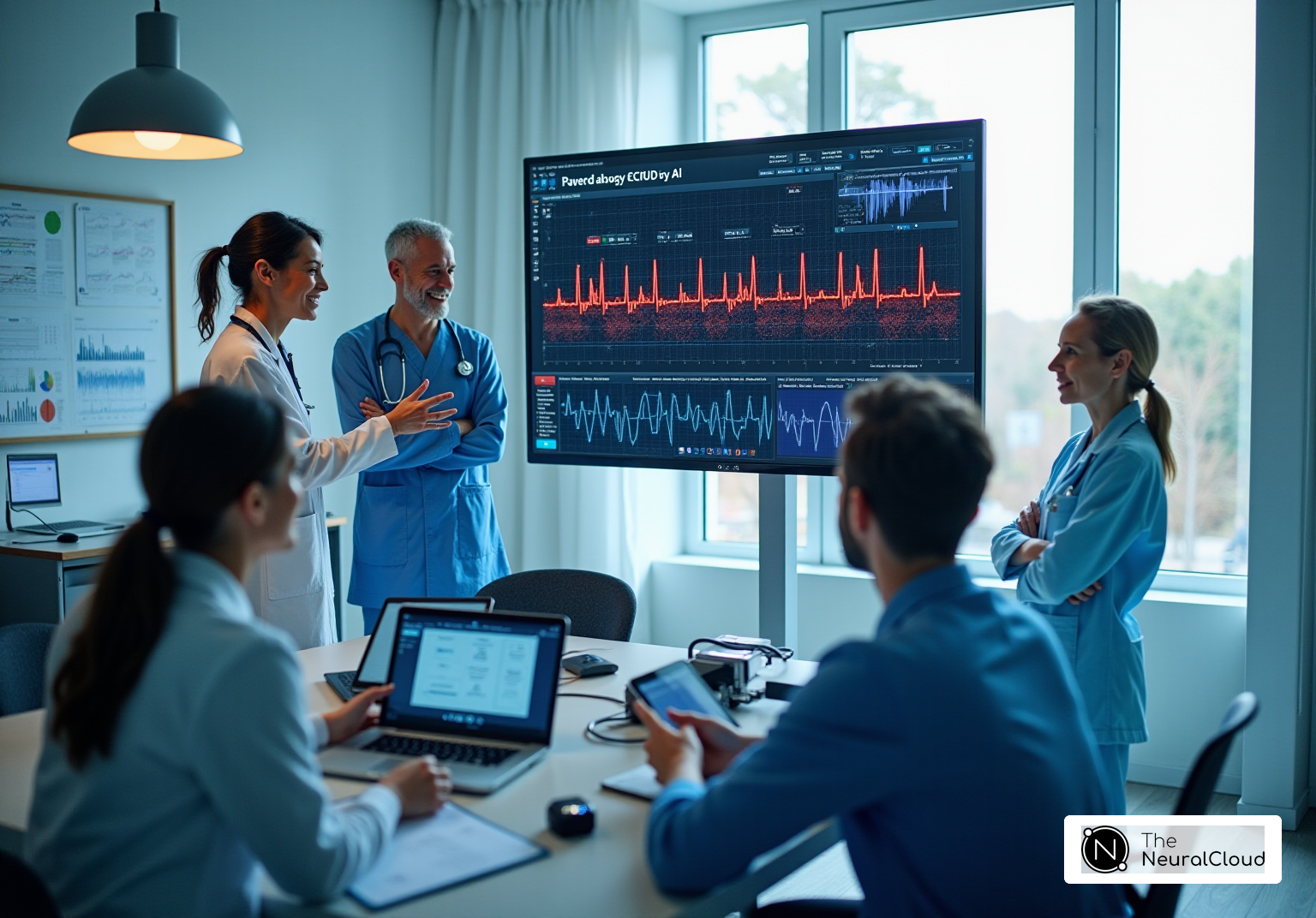Overview
The article highlights the importance of electrocardiogram (ECG) ST segment elevation, underscoring its vital role in diagnosing myocardial infarction (MI). It emphasizes the necessity for accurate interpretation and the integration of advanced technologies to improve diagnostic precision. The discussion includes the features of the MaxYield™ platform, which automates ECG analysis, minimizes noise, and assists healthcare professionals in quickly identifying critical changes. This ultimately enhances patient outcomes by facilitating timely and accurate diagnoses.
The MaxYield™ platform offers several key features that address common challenges in ECG analysis:
- By automating the analysis process, it reduces the potential for human error and streamlines workflows.
- The platform's ability to filter out noise ensures that healthcare professionals can focus on the most relevant data, allowing for more effective decision-making in critical situations.
The advantages of using the MaxYield™ platform extend beyond improved accuracy. Healthcare professionals benefit from increased efficiency, as the platform enables faster identification of significant ECG changes. This speed is crucial in emergency settings where timely intervention can significantly impact patient outcomes. Furthermore, the user-friendly interface of the platform makes it accessible for both technical and non-technical staff, promoting widespread adoption across healthcare teams.
In conclusion, the integration of the MaxYield™ platform in ECG analysis represents a significant advancement in the field. By enhancing diagnostic precision and supporting healthcare professionals in their decision-making processes, it contributes to better patient care and outcomes. The importance of accurate ECG interpretation cannot be overstated, and technologies like MaxYield™ are essential in meeting the challenges faced in modern healthcare.
Introduction
The landscape of cardiac health monitoring is evolving rapidly, particularly regarding the critical role of electrocardiogram (ECG) ST segment elevation as an indicator of myocardial infarction. Healthcare professionals face significant challenges in accurately interpreting these signals. In this context, the integration of advanced technologies, such as Neural Cloud Solutions' MaxYield™ platform, emerges as a game-changer.
This article explores seven pivotal insights into the significance of ST segment elevation, detailing how innovative tools and training can enhance diagnostic accuracy and ultimately improve patient outcomes. Moreover, it addresses the challenges developers encounter in harnessing these advancements and discusses how they can ensure that healthcare providers are equipped to respond effectively to cardiac emergencies.
Neural Cloud Solutions: MaxYield™ for Enhanced ECG Signal Clarity
The 'Neural Cloud Solutions' MaxYield™ platform is revolutionizing ECG evaluation by employing advanced AI algorithms that enhance signal clarity and tackle critical challenges such as noise and signal artifacts. This innovative platform processes over 200,000 heartbeats in under five minutes, providing that effectively isolates key features, including P-waves, QRS complexes, and T-wave intervals.
One of the standout features of MaxYield™ is its automation of ECG waveform labeling. This empowers healthcare professionals to focus on high-level decision-making, alleviating the burden of manual tasks. As a result, workflows are streamlined, and diagnostic accuracy is significantly improved, enabling clinicians to confidently identify cardiac events and enhance patient outcomes.
Additionally, the platform's continuous learning model ensures that its algorithms evolve over time, further enhancing accuracy and efficiency. The integration of this cutting-edge technology into clinical settings exemplifies the latest advancements in ECG signal clarity, illustrating how AI can transform traditional practices into efficient, data-driven processes.
MaxYield™ is designed to be scalable and device-agnostic, making it a versatile solution suitable for various healthcare applications. This adaptability underscores its potential to address the diverse needs of the healthcare sector, ultimately contributing to improved patient care.

Understanding ST Segment Elevation: Key Indicators of Myocardial Infarction
The electrocardiogram ST segment elevation serves as a crucial indicator for myocardial infarction, especially in the context of ST-rise myocardial infarction (STEMI). This condition is characterized by a new rise of the ST segment at the J point in two adjacent leads, exceeding a threshold of 0.1 mV. The capability to precisely identify these increases is essential, as timely acknowledgment can significantly affect patient outcomes. Cardiologists emphasize that early detection of ST segment rise is vital for initiating appropriate treatment, which can greatly reduce the risk of complications and enhance survival rates.
In emergency medicine, the prevalence of STEMI underscores the necessity for advanced tools that can reliably identify electrocardiogram ST segment elevation and these critical changes. The MaxYield™ platform by Neural Cloud Solutions exemplifies such technology, showcasing features that automate the detection of electrocardiogram ST segment elevation. This automation not only streamlines the ECG analysis process but also supports healthcare professionals in making informed decisions swiftly.
Notably, the incidence of STEMI hospitalization rates decreased from 52 to 36 per 100,000 hospitalizations from 2008 to 2019, reflecting the evolving landscape of this condition. As the occurrence of STEMI continues to rise, particularly among younger populations, the significance of accurate electrocardiogram ST segment elevation evaluation cannot be overstated. Furthermore, the MaxYield™ platform processes over 200,000 heartbeats in under five minutes, demonstrating its effectiveness in enhancing ECG analysis.
As Dr. Michos states, "The early detection of ST segment rise is critical in improving patient outcomes and reducing mortality rates." This highlights the importance of and ultimately enhance patient care.
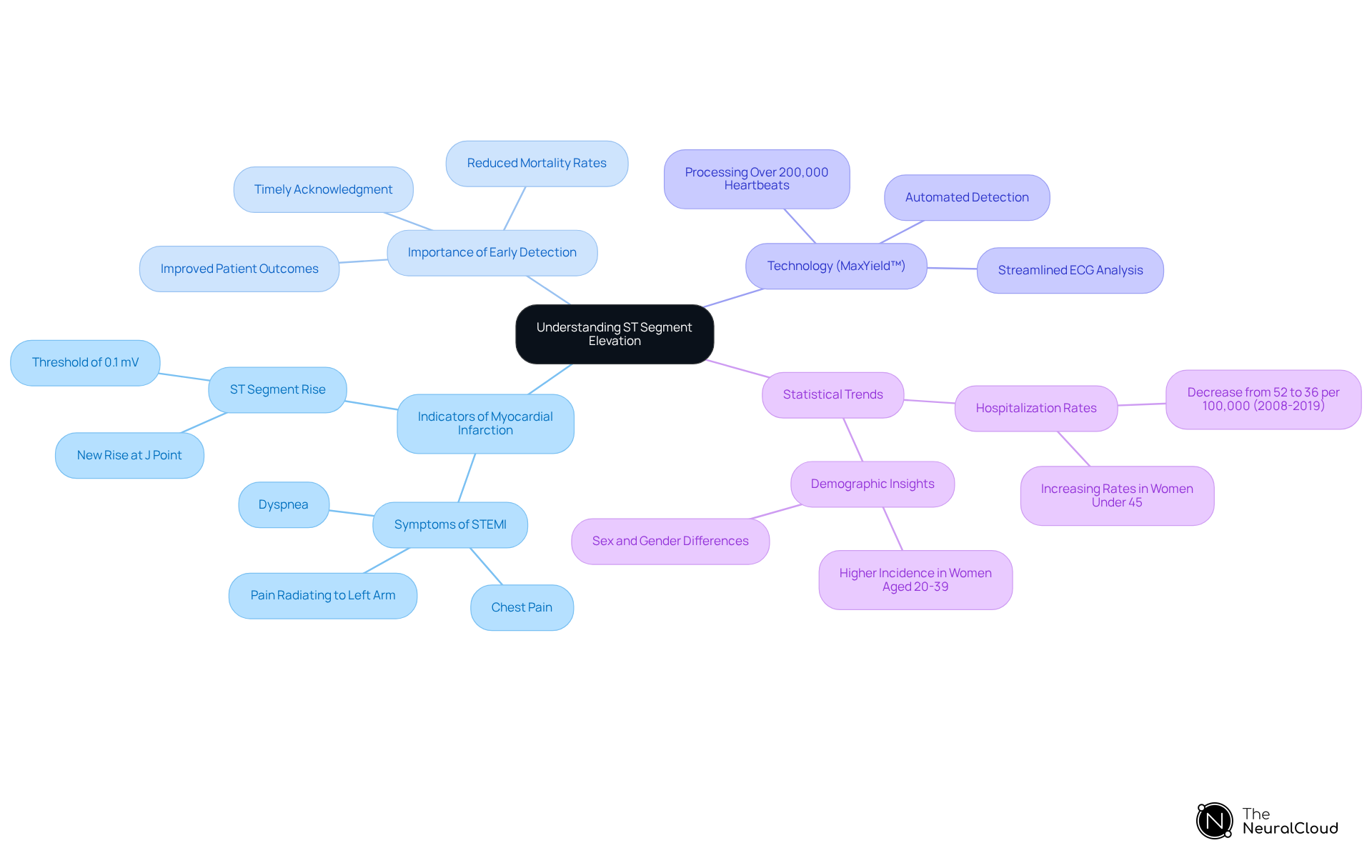
Differentiating Non-Ischemic Causes of ST Segment Elevation
Non-ischemic causes of ST segment rise can mimic myocardial infarction, which may lead to potential misdiagnosis. Conditions such as:
- Pericarditis
- Early repolarization
- Brugada syndrome
can present with electrocardiogram ST segment elevation. To address these challenges in , developers should incorporate algorithms capable of differentiating these conditions based on specific ECG patterns. This approach not only enhances the reliability of diagnostic tools but also supports healthcare professionals in making informed decisions. By improving the accuracy of ECG interpretations, the risk of misdiagnosis can be significantly reduced.
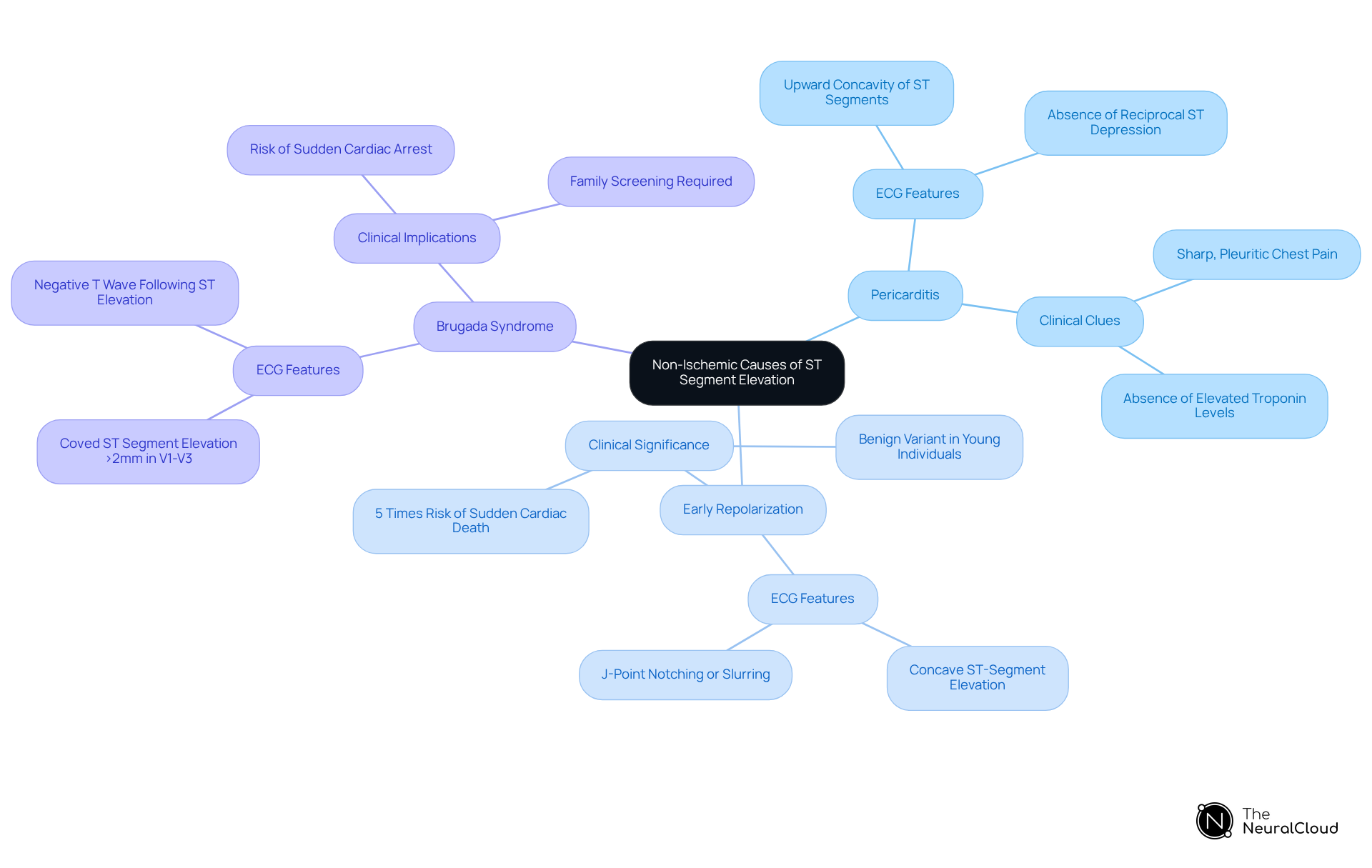
Utilizing Advanced Algorithms for Noise Reduction in ECG Analysis
Advanced algorithms are essential for improving the clarity and precision of ECG evaluation by effectively minimizing noise and artifacts. Techniques such as , wavelet transforms, and machine learning have demonstrated significant success in this area.
For example, the BiLSTMAE-CGAN model excels in ECG denoising, adeptly extracting temporal features from noisy signals. Recent studies highlight that adjusting the sample length is vital for achieving optimal denoising results, which can greatly enhance signal clarity.
Researchers like Ming Zeng stress that noise reduction methods are critical for acquiring high-quality ECG data, which is necessary for accurate diagnoses of heart diseases. As we approach 2025, the latest advancements in noise reduction are evolving, particularly with machine learning models that adapt to varying noise conditions, thereby further improving the reliability of ECG readings.
Developers are encouraged to focus on innovative strategies such as adaptive filtering and the continuous learning model of the MaxYield™ platform to ensure their ECG analysis systems provide the highest standard of data for clinical applications.
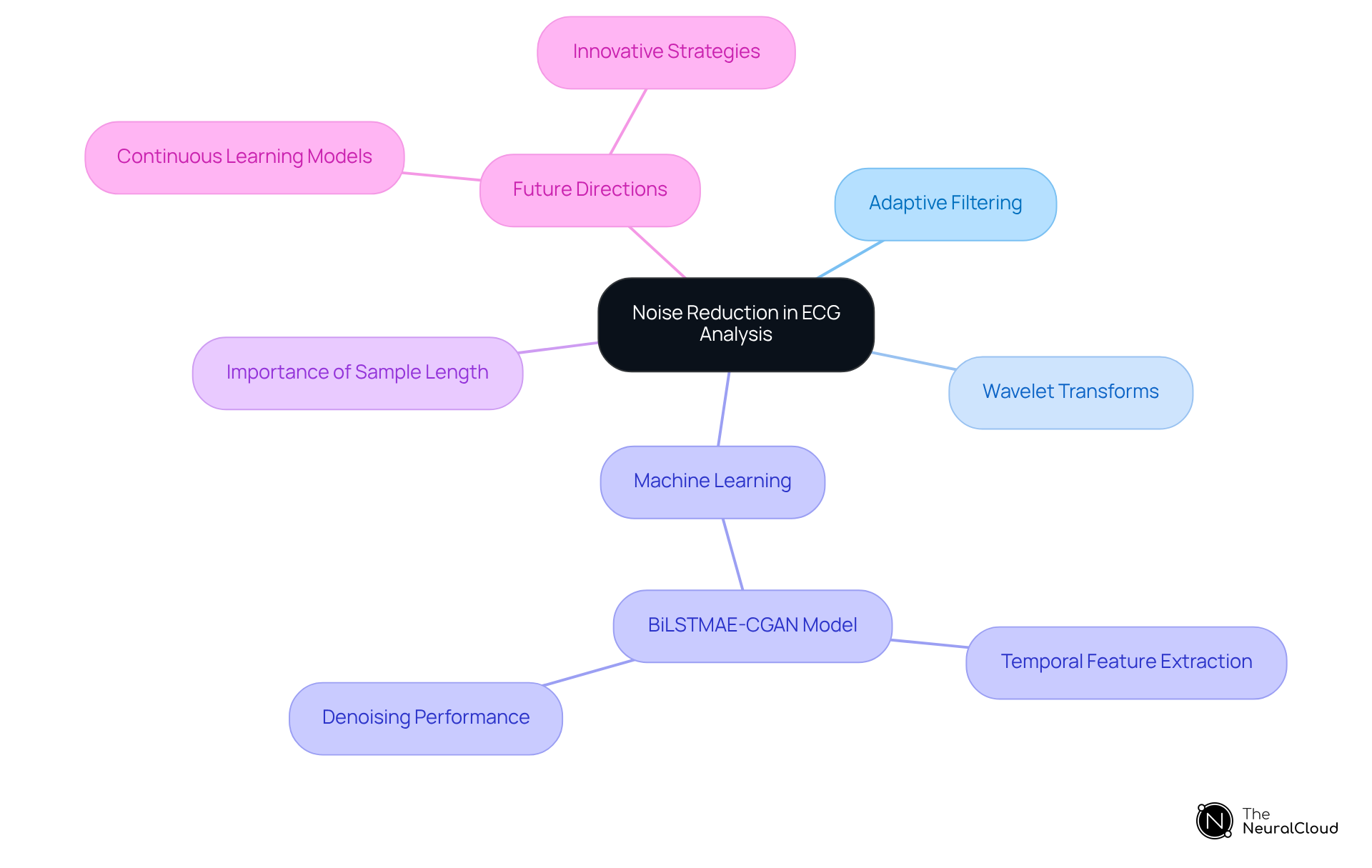
Clinical Implications of ST Segment Elevation in Emergency Medicine
In emergency medicine, the prompt recognition of electrocardiogram ST segment elevation is vital for diagnosing ST-Elevation Myocardial Infarction (STEMI) and initiating timely treatment. Delays in this acknowledgment can significantly raise morbidity and mortality rates among individuals. For instance, studies have demonstrated that in-hospital mortality for individuals who received a timely ECG was 6.0% compared to 10.9% for those with untimely ECGs, underscoring the critical importance of prompt ECG acquisition.
The creators of tools for evaluating electrocardiogram ST segment elevation must prioritize the integration of real-time alerts. Such alerts enable healthcare professionals to act swiftly, thereby improving outcomes for those receiving care and optimizing the efficiency of emergency services. The implementation of , such as those found in the MaxYield™ platform, which processes over 200,000 heartbeats in under five minutes, can further streamline this process. This ensures that critical cardiac events are identified with greater accuracy and speed.
Furthermore, it is crucial to acknowledge that 25% of 'non-STEMI' individuals experience acute coronary occlusion, highlighting the necessity for accurate ECG evaluation in emergency situations. The difficulties presented by the COVID-19 pandemic have underscored the necessity of establishing real-time alerts in ECG evaluation to enhance care for individuals.
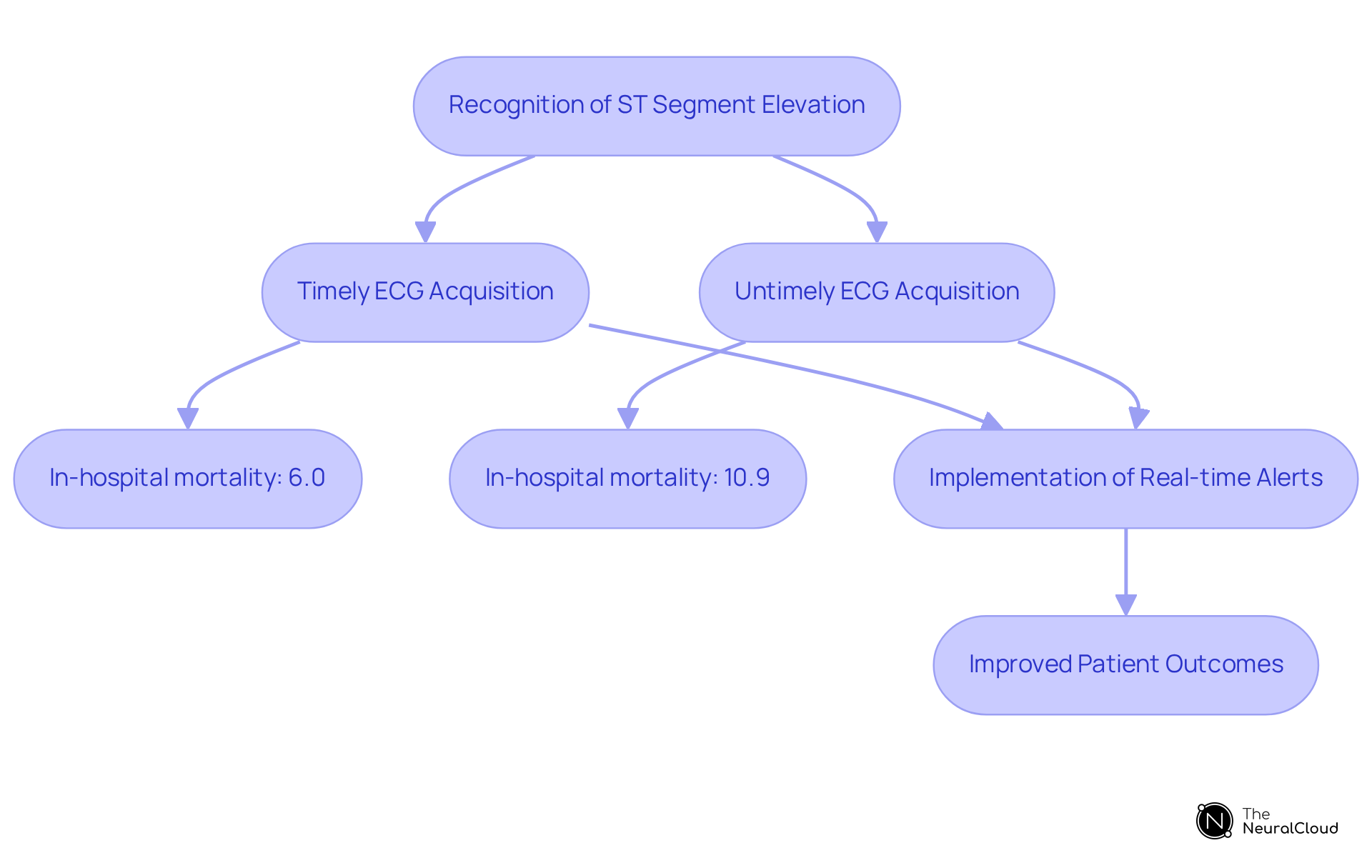
The Importance of Continuous ECG Monitoring for ST Segment Changes
Continuous ECG monitoring is essential for identifying changes in electrocardiogram ST segment elevation that may indicate evolving cardiac conditions. This proactive approach facilitates the , enabling immediate clinical intervention.
Studies indicate that long-term continuous ECG monitoring can capture significant arrhythmias that mobile cardiac telemetry (MCT) often overlooks, with detection rates increasing by 209% when comparing these two methods.
As healthcare technology progresses, developers should prioritize the integration of continuous monitoring features into their ECG assessment tools, thereby enhancing safety for individuals and improving care outcomes.
Cardiologists, including Mark Willcox, MD, stress that precise readings from cardiac monitors are vital for clinical decision-making. This highlights the necessity for advanced technologies like the MaxYield™ platform, which provides real-time insights into electrocardiogram ST segment elevation changes.
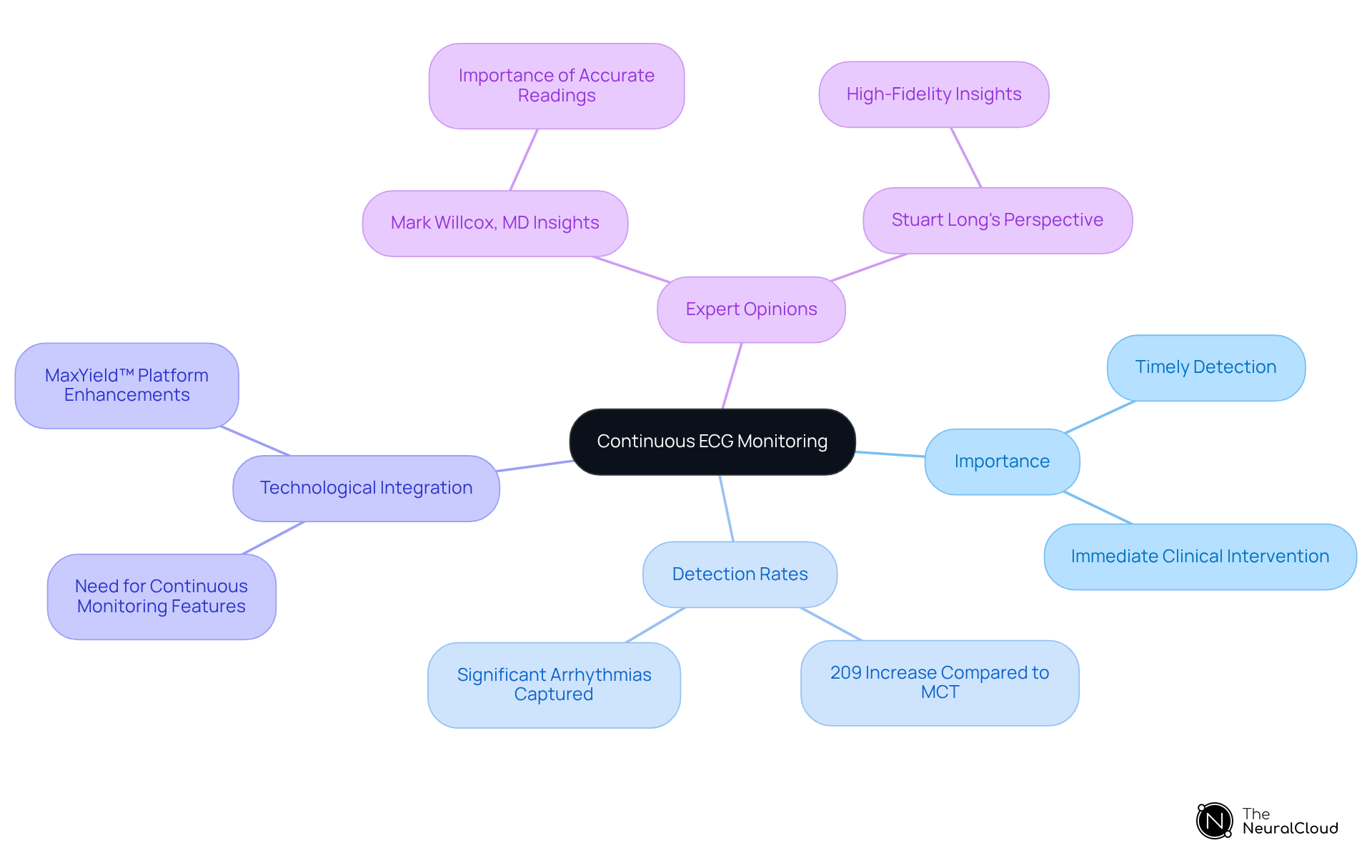
Integrating ECG Analysis Tools into Clinical Workflows for Improved Outcomes
Integrating ECG evaluation tools into clinical processes is essential for improving their effectiveness and enhancing patient outcomes. These tools offer healthcare professionals that facilitate easy access to and interpretation of ECG data. Furthermore, ensuring compatibility with electronic health records (EHR) systems can streamline workflows, significantly boosting the overall efficiency of cardiac care. By addressing these aspects, developers can create solutions that not only meet the needs of healthcare providers but also contribute to better patient care.
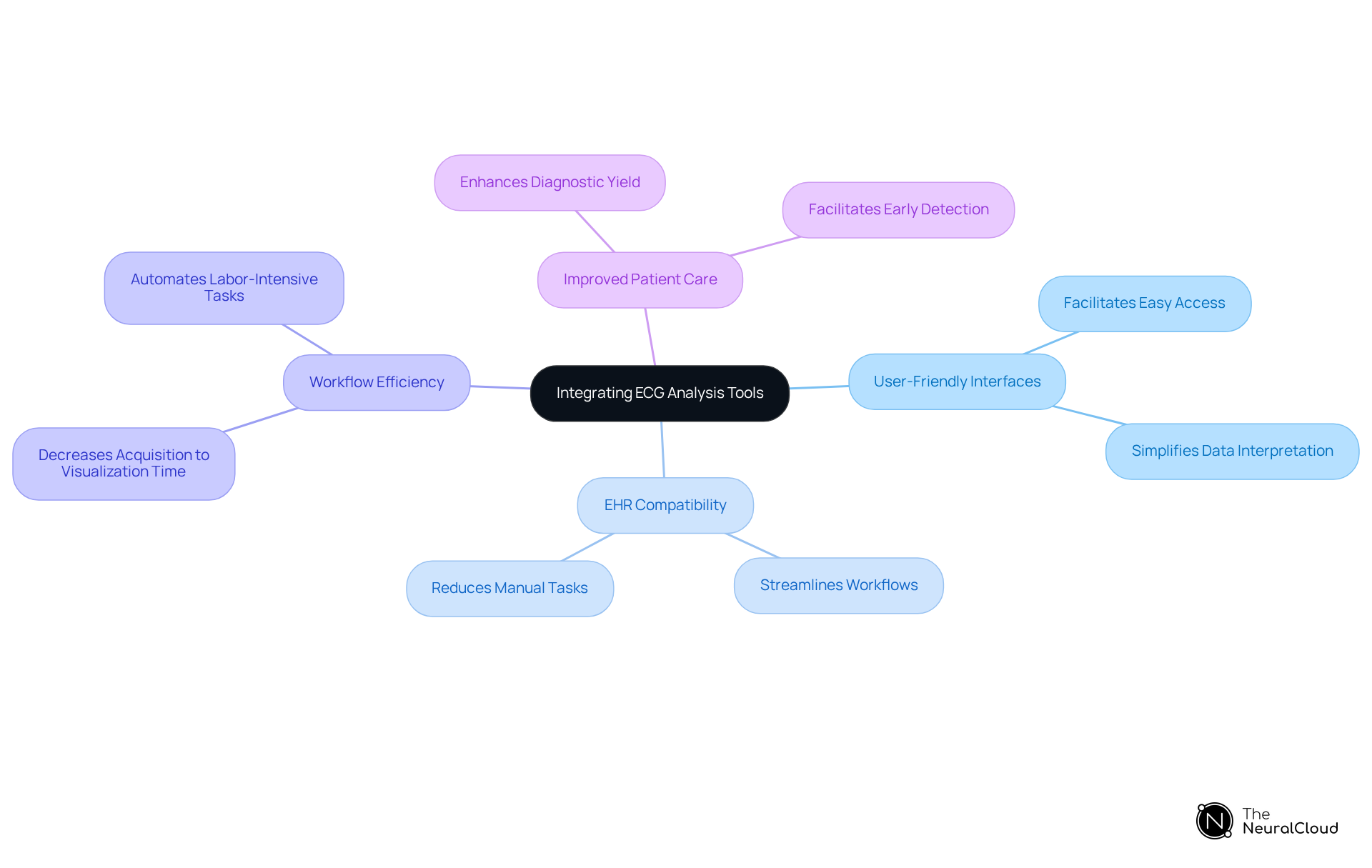
Training Healthcare Professionals in ECG Interpretation: Recognizing ST Segment Elevation
Training healthcare professionals in ECG interpretation is crucial for accurately identifying abnormalities such as electrocardiogram ST segment elevation and other critical cardiac conditions. Developers should prioritize creating educational resources, such as tutorials, interactive modules, and webinars, to accompany their ECG analysis tools. These resources not only improve the competency of healthcare providers but also significantly enhance patient care and outcomes.
Dr. Zimmerman emphasizes the importance of ongoing education, stating, "Proficiency in ECG interpretation is not where it should be," which underscores the need for structured training programs. Recent studies indicate that participants engaged in targeted ECG training showed a marked improvement in their interpretation skills, with average competency scores rising from 5.13 to 7.5 out of 10 after structured educational interventions. The average score for ECG interpretation competency among participants was only 5.3 out of 10, highlighting the current inadequacy in skills and the necessity for improved training.
In 2025, innovative educational resources focused on identifying electrocardiogram ST segment elevation will be essential. These resources should cover both basic and advanced concepts, ensuring that clinicians are well-equipped to interpret ECGs accurately. Training should also encompass both basic and , aligning with the focus on recognizing electrocardiogram ST segment elevation. By integrating these educational resources into their services, developers can significantly enhance the skills of healthcare practitioners, ultimately leading to better diagnostic accuracy and improved outcomes for those receiving care.
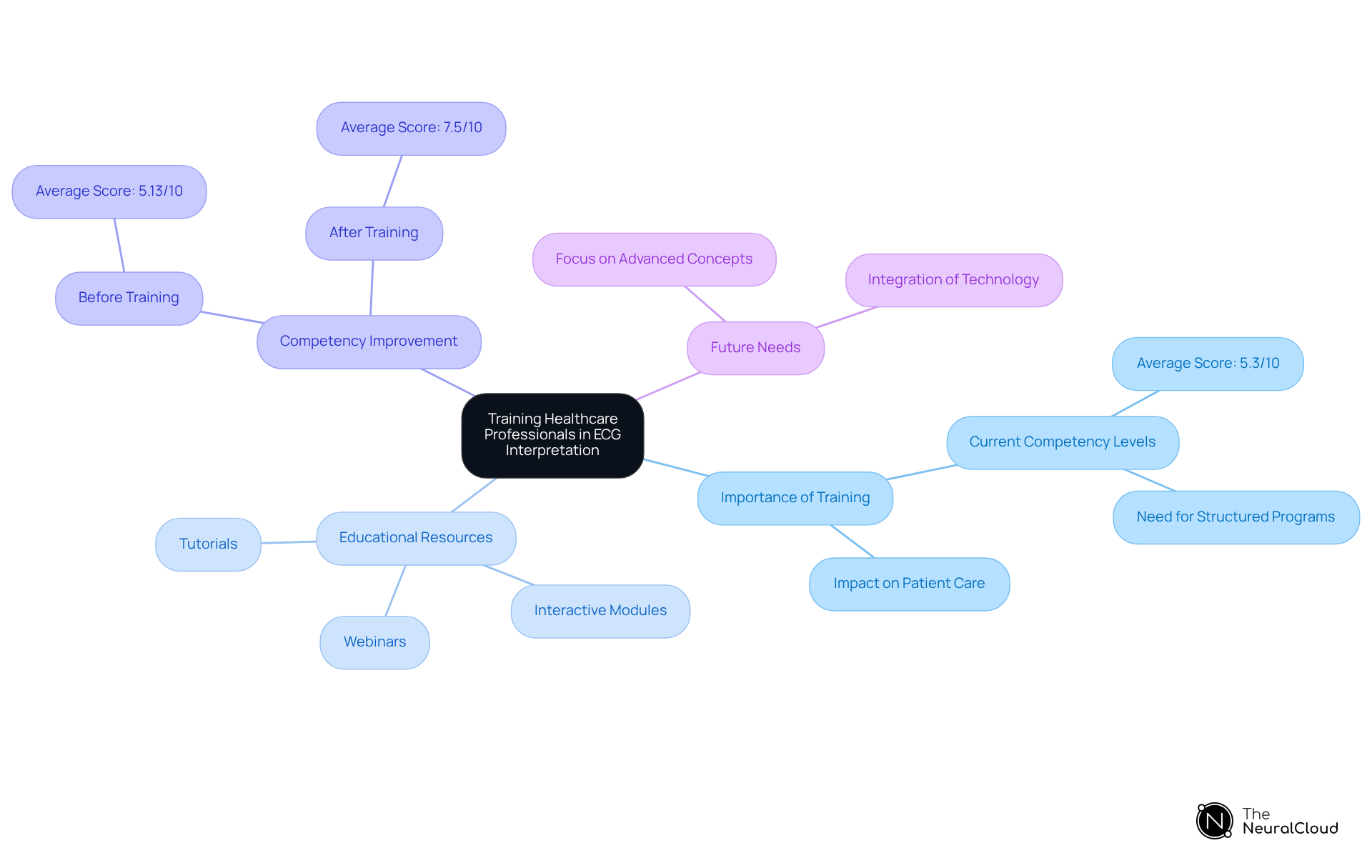
Future of ECG Technology: Advancements in Wearable Devices for Monitoring
The future of ECG technology is increasingly intertwined with advancements in wearable devices that facilitate continuous cardiac health monitoring. These innovative devices provide real-time information to both individuals and healthcare providers, enabling proactive management of heart conditions. For instance, studies have shown that wearable devices can detect atrial fibrillation (AFib) more frequently than traditional medical devices, highlighting their effectiveness in early detection and ongoing monitoring. The Apple Watch, for example, has a positive predictive value of 84% for identifying AFib, demonstrating the potential of wearables in cardiac health.
Developers should prioritize the incorporation of advanced features, such as AI-driven analytics, which can enhance predictive capabilities and improve health outcomes. As Veena Misra noted, "Wearables will become more and more a predictor of health." The MaxYield™ platform exemplifies this trend by processing over 200,000 heartbeats in under five minutes and providing actionable insights that empower healthcare professionals to make informed decisions.
Additionally, a study involving 2,454 individuals who uploaded over 125,000 Apple Watch ECGs highlights the practical use and confirmation of wearable technology in real-world environments. As the technology progresses, insights from tech developers emphasize the significance of smooth data integration and user-friendly interfaces. This ensures that wearable ECG devices not only fulfill clinical demands but also and adherence.
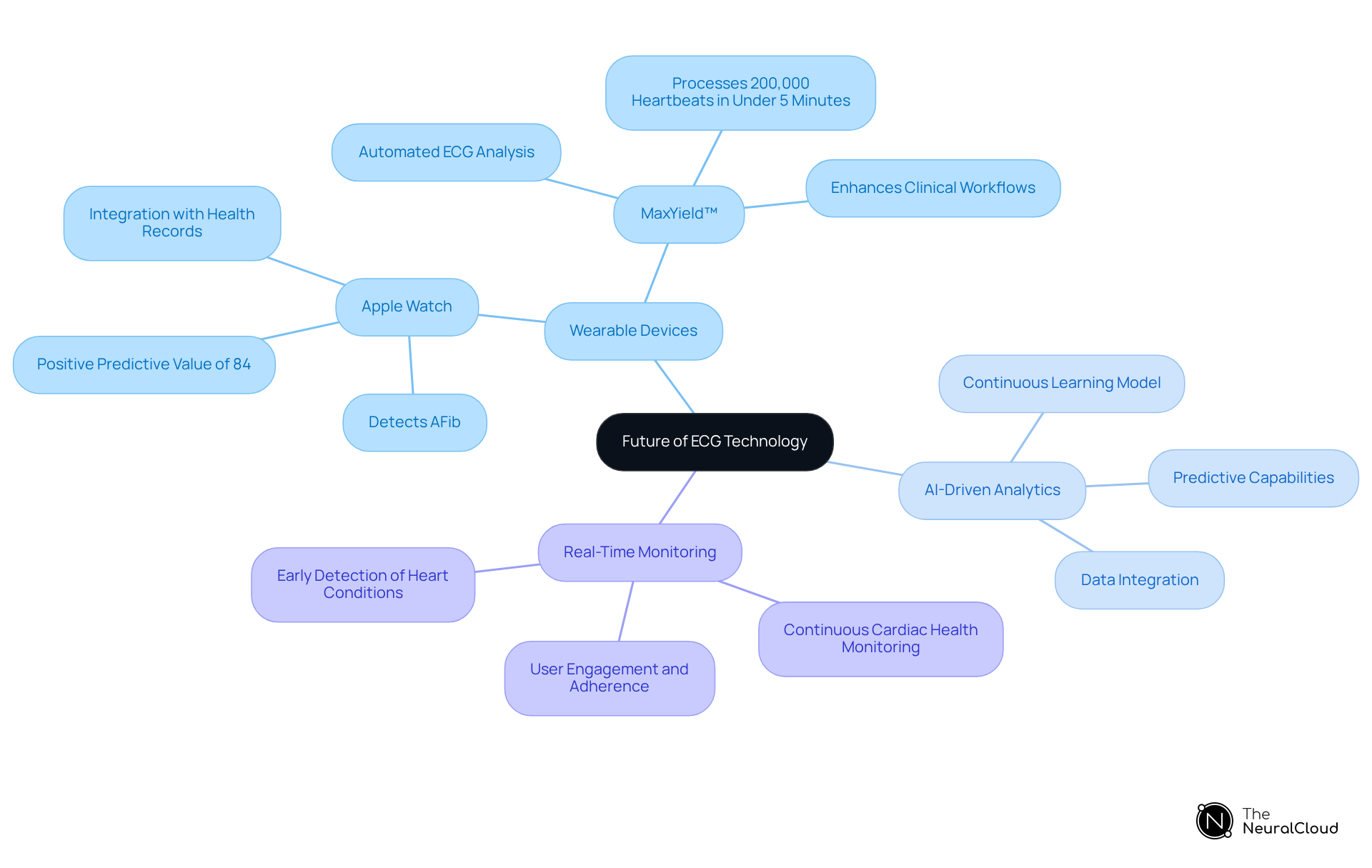
Key Takeaways on ST Segment Elevation and Cardiac Health
Key takeaways regarding electrocardiogram ST segment elevation highlight its critical role as an indicator of myocardial infarction. It is essential to differentiate between ischemic and non-ischemic causes to ensure accurate diagnosis. Additionally, the integration of advanced algorithms for noise reduction is necessary to enhance electrocardiogram ST segment elevation analysis.
- Continuous monitoring and effective training for healthcare professionals are vital for improving patient outcomes.
- Developers should prioritize these aspects in their ECG analysis tools to and clinical efficiency.
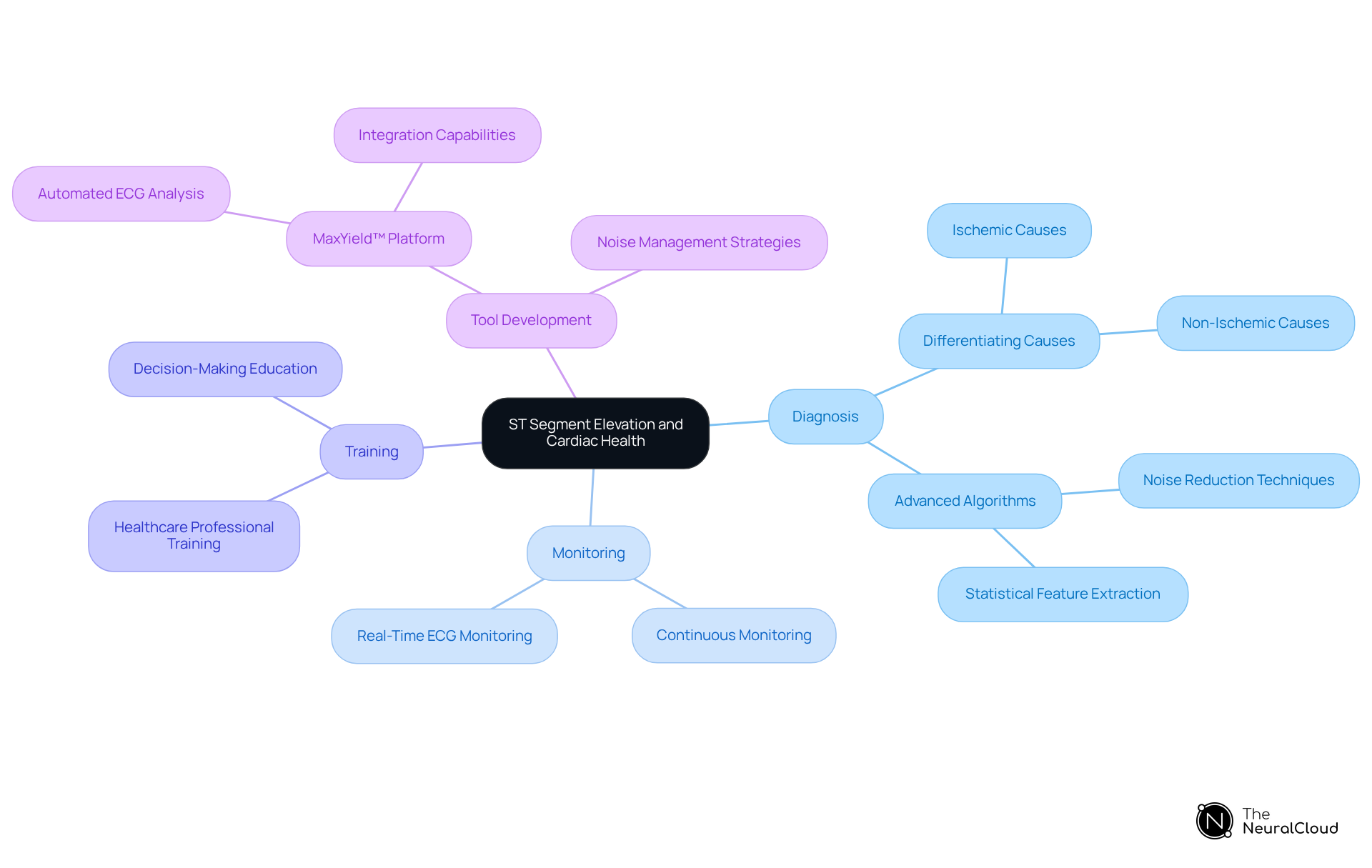
Conclusion
The exploration of electrocardiogram (ECG) ST segment elevation reveals its pivotal role in diagnosing myocardial infarction and highlights the importance of advanced technologies in improving patient outcomes. Challenges in ECG analysis can hinder timely diagnoses; however, leveraging innovative platforms like Neural Cloud Solutions' MaxYield™ enhances ECG signal clarity. This improvement enables more accurate and timely diagnoses, streamlining workflows and empowering clinicians to focus on critical decision-making.
Key insights from the article underscore the necessity of differentiating between ischemic and non-ischemic causes of ST segment elevation. Continuous monitoring is significant, and there is a critical need for training healthcare professionals in ECG interpretation. As the landscape of cardiac care evolves, incorporating advanced algorithms for noise reduction and real-time alerts will further refine diagnostic accuracy and clinical efficiency.
Ultimately, advancements in ECG technology, particularly through wearable devices and AI-driven analytics, present an exciting future for cardiac health monitoring. By prioritizing these developments and fostering ongoing education, the healthcare community can significantly enhance patient care and outcomes. Timely and accurate diagnoses must become the standard in managing cardiac conditions.
Frequently Asked Questions
What is the MaxYield™ platform and what does it do?
The MaxYield™ platform is a Neural Cloud Solutions technology that enhances ECG evaluation using advanced AI algorithms to improve signal clarity and address challenges like noise and artifacts. It processes over 200,000 heartbeats in under five minutes for precise beat-by-beat analysis.
How does MaxYield™ improve ECG analysis?
MaxYield™ automates ECG waveform labeling, allowing healthcare professionals to focus on high-level decision-making, streamlining workflows, and improving diagnostic accuracy for better identification of cardiac events.
What is the significance of ST segment elevation in ECG interpretation?
ST segment elevation is a crucial indicator of myocardial infarction (specifically STEMI) and is characterized by a new rise of the ST segment at the J point in two adjacent leads, exceeding 0.1 mV. Early detection is vital for timely treatment and improved patient outcomes.
How does MaxYield™ assist in detecting ST segment elevation?
The MaxYield™ platform automates the detection of ST segment elevation, streamlining the ECG analysis process and enabling healthcare professionals to make informed decisions quickly.
What are some non-ischemic causes of ST segment elevation?
Non-ischemic causes that can mimic myocardial infarction include pericarditis, early repolarization, and Brugada syndrome. These conditions require careful differentiation to avoid misdiagnosis.
Why is it important to differentiate between ischemic and non-ischemic causes of ST segment elevation?
Differentiating between these causes is crucial because misdiagnosis can lead to inappropriate treatment. Incorporating algorithms that identify specific ECG patterns can enhance diagnostic reliability and reduce misdiagnosis risk.
How does the continuous learning model of MaxYield™ benefit its users?
The continuous learning model allows MaxYield™ algorithms to evolve over time, enhancing accuracy and efficiency in ECG analysis, which ultimately improves patient care.
Is MaxYield™ adaptable for various healthcare applications?
Yes, MaxYield™ is designed to be scalable and device-agnostic, making it a versatile solution that can address the diverse needs of the healthcare sector.



